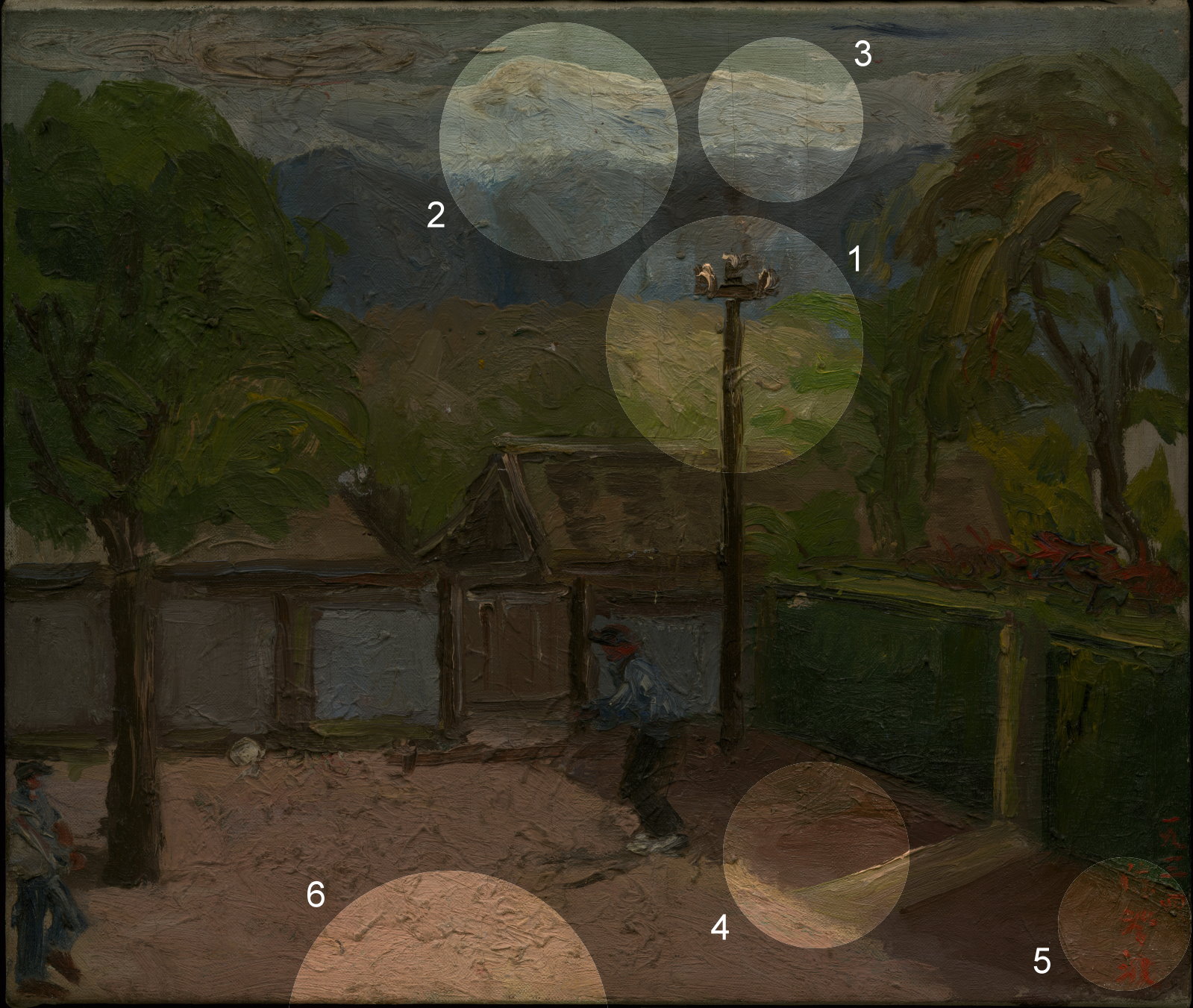玉山暖冬
為提供使用者有文書軟體選擇的權利,本文件為ODF開放文件格式,建議您安裝免費開源軟體 ([連結])

玉山暖冬
Mild Winter at Mt. Jade
玉山の暖冬
1934, 畫布油彩, 38×45cm
oil on canvas
画布油彩
覆蓋在山脈上的雪白提示了冬日的降臨,但畫境裡的嘉義,仍有溫煦的陽光。日頭在圍牆的背面拉出了長長的影子,也在畫境裡漫成了悠閒安適的氛圍。暖洋洋的空氣裡,人們的臉孔,似乎也被烘成了紅通通的顏色。
The white snow blanketing the high mountain peaks hints at the approach of winter, but Chiayi is still bathed in warm sunlight. Sunshine streaming in from behind the wall casts a long shadow across the courtyard, where two people enjoy the balmy weather, their faces baked red from the sun. An atmosphere of carefree relaxation characterizes this scene.
山脈を覆う真っ白な雪が冬の訪れを示していますが、画中の嘉義は暖かい陽光に包まれています。日の光が壁に長い影を作り、絵の中に安らかでのどかな雰囲気が満ちています。温もりのある空気のうちに、人々の顔も赤く染められているようです。
在陳澄波的畫布上,故鄉嘉義這塊土地,多半散發著溫熱的氣息。而對你來說,家鄉的印象與顏色,又會是什麼樣子的呢?
Nearly all of Chen Cheng-po’s paintings of his hometown Chiayi radiate warmth. What colors and impressions come to mind when you think of your own hometown?
陳澄波がキャンバスに描いた故郷の嘉義という土地、その多くに暖かさが感じられます。皆さんの故郷はどんな色でどんなイメージでしょうか。

1.電線桿與陳澄波
Electric poles
電柱と陳澄波
1913年,「嘉義電燈會社」成立,隨著發電設備的引進,電線桿也成為街道上的常見景物。同年,陳澄波北上求學。當他返回嘉義的時候,一定也驚訝於家鄉風景的改變,這種強烈印象或許也是他喜歡在畫作裡描繪電線桿的原因。
The Chiayi Lighting Corporation opened its doors in 1913 following the introduction of the technology and equipment necessary to generate electricity. That same year, Chen moved north to continue his studies. When he returned to Chiayi, he must have been quite surprised to see electric poles lining the city streets. Perhaps his astonishment at the changes in his hometown landscape is what led him to take an interest in these novelties, which became a recurrent motif in his paintings.
1913年に「嘉義電灯会社」が設立されると、それに合わせて発電設備も整えられ、電柱も街角でよく見かけるようになりました。その年、陳澄波は進学のために北部へ向かいました。嘉義に帰郷した陳澄波は、すっかり様変わりした故郷の風景をみて驚いたに違いありません。その時の強烈な印象が、画中に電柱を好んで描き入れた理由なのかもしれません。
2.玉山與嘉義
Mt. Jade and Chiayi
玉山と嘉義
1935年,在一篇名為「嘉義市與藝術」的文章裡,陳澄波如此熱烈地讚頌玉山帶給嘉義人的歡欣鼓舞:「早晨時候,新高主山總是與太陽公公一起露出笑顏,實在是很美麗的山峰,每天可以看到它的嘉義市民,是何等的幸福啊!」
In a 1935 article entitled “Chiayi and Art,” Chen wrote enthusiastically of the joy experienced by local residents at the sight of the mountain: “Each morning, Mt. Jade greets Grandfather Sun with a smile and we, the people of Chiayi, wake up to this stunning sight. How blessed we are!”
1935年、陳澄波は「嘉義市と芸術」と題された文章で、玉山が嘉義の人々に与えてくれる喜びと励ましに熱のこもった称賛を送っています。「明け方は新高山(ニイタカヤマ、玉山のこと)の主山がいつもお天道様といっしょに笑顔を見せてくれる。誠に美しい山峰で、毎日この山が見られる嘉義市民はなんと幸せなことだろうか!」
3.積雪的顏色
The color of snow
積雪の色
每年國曆的十一月至十二月之間,是玉山開始降雪的時節。在三到四個月的積雪期當中,隨著積雪的厚度增減,山頭的模樣也會不斷發生改變。而在陳澄波的風景畫裡,玉山的顏色表現,可能也因為節氣時令的差異而有所不同。
Each year, snow begins to fall on Mt. Jade around November or December. The mountaintop remains snow-covered for the following three to four months, and its appearance constantly changes depending on variations in the thickness of the snow. Mt. Jade takes on different hues in Chen’s works as well, reflecting these same changes in seasonal and atmospheric conditions.
玉山では毎年11月~12月頃に雪が降り始めます。積雪期間は3~4ヶ月ほどで、積雪量の増減により、山頂の姿も変化し続けます。陳澄波が描く風景画も、季節によって玉山の色彩表現に違いが見られるかもしれません。
4.陰影與時間
Shadows as indication of time
陰影と時間
圖像裡的細節線索,可以幫助我們掌握一件作品的時空背景。在這幅畫當中,圍牆、人物與樹的陰影都向左下角延伸,太陽的位置應在畫中場景的右後方,亦即嘉義東邊的山區。據此可知,陳澄波作畫的時間點,應是上午時分。
Details within a painting can provide contextual clues as to the space and time in which it was created. In Mild Winter at Mt. Jade, shadows cast by the wall, figures, and trees all slant down to the lower left corner. From this detail, we know that the sun must be behind the tree to the right, rising above the mountains east of Chiayi. Therefore, Chen painted this work in the morning.
絵図の細部を手がかりに、一つの作品の時空的背景がつかめます。この作品に描かれている塀や人物、樹木が作る影はいずれも左下に伸びています。太陽の位置は画中の場面の右後方に違いなく、嘉義東部の山間部にあたります。この点から、陳澄波がこの作品を描いたのは午前中だと考えられます。
5.簽名
Chen’s signatures
サイン
陳澄波的落款方式在不同時期頗有差異。這幅畫使用漢字簽寫,但在早期的作品當中,他有時候會以拼音字母表現其姓名的日文或臺語發音,有時則選擇畫上「CTH」(「陳澄波」的日文縮寫)三字相疊的自創圖樣,來當作簽名。
Chen used slightly different signatures throughout the decades. He signed this painting using Chinese characters, but in earlier works, he sometimes used the Romanized spelling of his name as pronounced in Japanese or Taiwanese. At other times he signed his paintings CTH, the abbreviation for the Romanized form of his name as pronounced in Japanese, with the three letters stacked one on the other and configured in a creative design.
陳澄波のサインは時期によってかなりの違いが見られます。この作品には漢字でサインしていますが、早期の作品だと、姓名の日本語または台湾語の発音がピンインで記されていることもあり、「CTH」(日本語発音のイニシャル)という3文字を重ねた、オリジナルの図案をサイン代わりにした作品もあります。
6.畫幅
Painting dimensions
画幅
1935年初,陳澄波曾在報上公開發表批判。他認為當時的臺灣畫家有意模仿日本畫壇,在美術展覽當中競相製作大型作品,成果卻往往充滿破綻。在他看來,只要表現出技巧與個性,即便是像這樣的小號畫幅,也會是理想的作品。
In early 1935, Chen published a newspaper editorial criticizing certain Taiwanese artists who, wanting to imitate their Japanese peers and win acclaim at fine arts exhibitions, created large-scale pieces which were unfortunately lacking in quality. In his opinion, the best art was not necessarily the largest. As long as an artwork conveyed the craftsmanship and personality of the artist, even if it were a painting as small as Mild Winter at Mt. Jade, it was a success.
陳澄波は1935年の初め、新聞紙上で批判的な文章を発表したことがあります。当時の台湾人画家は意図的に日本画壇の模倣をし、美術展で競うように大型の作品を制作しているが、結果は往々にして破綻しているという内容でした。陳澄波からすれば、技巧や個性を十分に表現できさえすれば、たとえこのような小品でも、理想的な作品になりえるという事だったのでしょう。
